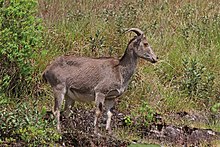Nilgiri tahr
| Nilgiri tahr | |
|---|---|

| |
| Male (left) | |

| |
| Female in Eravikulam National Park | |
| Scientific classification | |
| Domain: | Eukaryota |
| Kingdom: | Animalia |
| Phylum: | Chordata |
| Class: | Mammalia |
| Order: | Artiodactyla |
| Family: | Bovidae |
| Subfamily: | Caprinae |
| Tribe: | Caprini
|
| Genus: | Nilgiritragus Ropiquet & Hassanin, 2005 |
| Species: | N. hylocrius
|
| Binomial name | |
| Nilgiritragus hylocrius (Ogilby, 1838)
| |

| |
| Distribution of Nilgiri tahr | |
| Synonyms | |
|
Hemitragus hylocrius | |
The Nilgiri tahr (Nilgiritragus hylocrius) is an
It is the state animal of Tamil Nadu.[2]
Etymology
The genus name Nilgiritragus is derived from the
Taxonomy
The Nilgiri tahr was described as Capra warryato by Gray.[4]
Taxonomy
The species was formerly placed in the genus Hemitragus together with the Himalayan tahr (H. jemlahicus) and the Arabian tahr (Arabitragus jayakari). A 2005 phylogenetic analysis showed that the Himalayan and Arabian tahr are sisters of the genus Capra while the Nilgiri tahr is a sister of the genus Ovis and it was therefore separated into the monotypic genus Nilgiritragus in 2005.[5] The divergence from the common ancestor of Ovis and Nilgiritragus is estimated to about 2.7-5.2 million years ago. Estimates point to the genetic separation of the populations north (Nilgiris) and south (Anamalais) of the Palghat Gap about 1.5 million years ago.[6]
Description
The Nilgiri tahr is a stocky goat with short, coarse fur and a bristly mane. Males are larger than females and of darker colour when mature. Both sexes have curved horns, reaching up to 40 cm (16 in) for males and 30 cm (12 in) for females. Adult males weigh 80 to 100 kg (180 to 220 lb) and stand about 100 cm (39 in) tall at the shoulder. Adult males develop a light grey area on their backs, thus are called "saddlebacks".[2]
Distribution and habitat
The Nilgiri tahr can be found only in India. It inhabits the open
Threats
The Nilgiri tahr is primarily threatened by
Conservation
As few as 100 Nilgiri tahrs were left in the wild by the end of 20th century. Since that time, their numbers have increased somewhat; in a comprehensive study of the Nilgiri tahr population in Western Ghats, the WWF-India has put the population at 3,122.
See also
References
- ^ . Retrieved 19 November 2021.
- ^ a b Prater, S. H. (1971) [1948]. The book of Indian Animals. Bombay: Bombay Natural History Society.
- ^ Liddell, H. G.; Scott, R. (1940). "τράγος". A Greek–English Lexicon (Ninth ed.). Oxford: Oxford University Press.
- OCLC 4008435.
- PMID 15904863.
- PMID 33474132.
- ^ "Nilgiri tahr population over 3,000: WWF-India". The Hindu. 3 October 2015.
- ^ "Munnar Hill Station". Kerala Tourism. Archived from the original on 18 January 2014. Retrieved 21 June 2012.
- ^ "Bonnet Macaque tops in wildlife survey in Kanyakumari district"
- ^ "Squeezing Life out of Ponmudi"
Further reading
- Rice, G. Clifford, Reproductive biology of Nilgiri tahr, Journal of Zoology, London (PDF Archived 20 June 2013 at the Wayback Machine)
External links
- ARKive - images and movies of the Nilgiri tahr (Hemitragus hylocrius)
- Nilgiri tahr information (archived)



